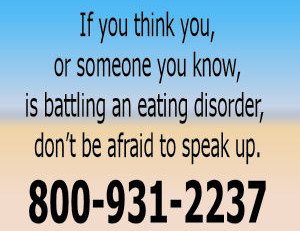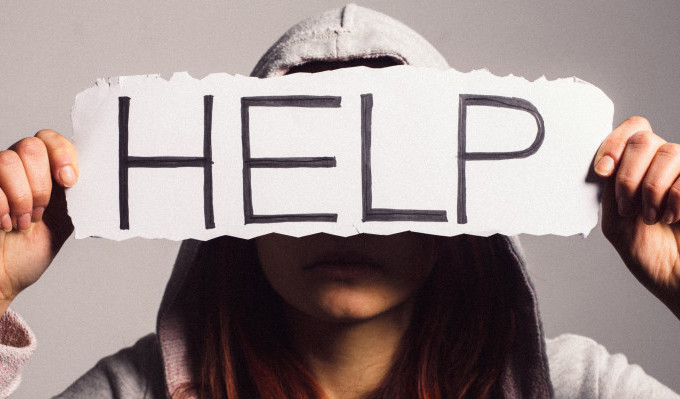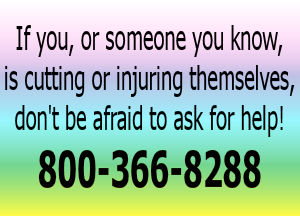Teens may engage in harmful behaviors as a way of coping, expressing and dealing with deep distress and emotional pain.
To some teens, causing harm to themselves is the only way they know how to cope with feelings like sadness, self-loathing, emptiness, guilt, control and rage.
The problem is that the relief that comes from self-harming doesn’t last very long. It’s like slapping on a Band-Aid when what you really need are stitches. It may temporarily stop the bleeding, but it doesn’t fix the underlying injury. And it also creates its own problems.
Most teens who self-harm try to keep what they’re doing secret. They may feel ashamed or maybe think that no one would understand. Two of the most common harmful behaviors exhibited by teens are cutting and eating disorders.
Eating Disorders
Eating disorders are characterized by a persistent pattern of dysfunctional eating or dieting behavior. These patterns of eating behavior are associated with significant emotional, physical, and interpersonal distress.
Eating disorders can be found across the socioeconomic spectrum and are colorblind. They involve self-critical, negative thoughts and feelings about body image. Eating habits then become unhealthy and affect physical and emotional well-being. Onset often begins with adolescence, but can it can start even younger.
The way media and culture glorify the very thin is absolutely part of the problem...
- Up to 24 million people in the U.S., all ages and genders, have an eating disorder
- Anorexia is the single leading cause of death for women between the ages of 15 – 24, and the third most common chronic illness among adolescents
- Eating disorders do not only affect women. An estimated 10-15% of people with anorexia or bulimia are male.
- Athletes are more prone to developing an eating disorder than the rest of the population, with significantly higher rates among elite athletes.
- Eating disorders can cause depression and other mental illnesses. Lack of food and proper nutrition reduces serotonin and endorphins in the brain.
More than one-third of persons with an eating disorder begin with normal dieting and progress to pathological behavior. Over one-half of teenage girls and nearly one-third of teenage boys use some form of unhealthy weight control behaviors such as skipping meals, fasting, smoking cigarettes, vomiting, and taking laxatives.
If left untreated, eating disorders – anorexia nervosa, bulimia nervosa or another unspecified eating disorder – can be fatal.
The National Eating Disorder Association (NEDA) created materials to educate on eating disorders:
- The NEDA Parent Toolkit is for anyone who wants to understand more about how to support a family member or friend affected by an eating disorder. You will find answers to your insurance questions; signs, symptoms and medical consequences; information about treatment and levels of care; and questions to ask when choosing a treatment provider.

Cutting
Cutting refers to any sort of self-harm which involves inflicting injuries or pain on one’s own body. Mental health professionals define the act of cutting as an unhealthy coping mechanism designed to immediately alleviate tension, anxiety, stress and depression - not as a suicide attempt. In other words, when reality feels overwhelming, some turn to cutting themselves, several times a day, with sharp objects in order to relieve their inner pain.
Warning signs of cutting and self-harm include:
- Increase in frequency and distribution of piercing and/or tattoos
- Scarification and branding (any activity that involves burning or cutting the flesh)
- Decisions to have body modification or procedures done under the influence of drugs or alcohol
- Altered mood states
- Poor self-image and self-esteem
- Cuts and/or scratches on the skin
Regardless of someone’s background, the common link in all self-injurers is the need for consistent, relationship-oriented support, nurturance and guidance. In addition to the constant struggle with the desire to cut one’s own body, eating disorders, hair pulling, piercing, tattooing and skin burning are other conditions that may co-exist with cutting.
Visit the Virtual Save A Life Wellness Fair for more resources!
Related Posts
Youth Mental Health First Aid Course
Sometimes, first aid isn’t a bandage, or CPR, or the Heimlich, or calling 911. Sometimes, first aid is YOU! A young person you know could be experiencing a mental health challenge or crisis. You can help! You are more likely to encounter someone — friend, family member, student, neighbor or member of the community […]



